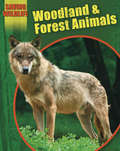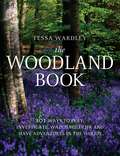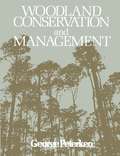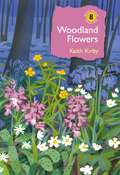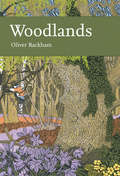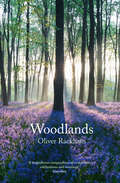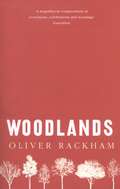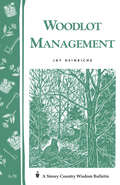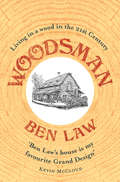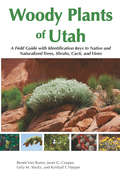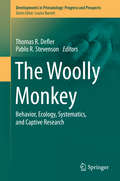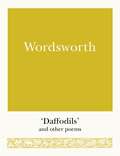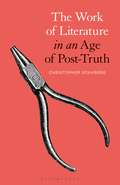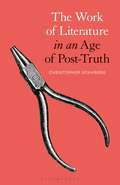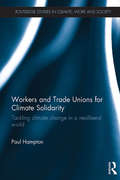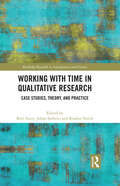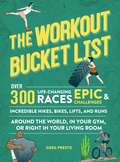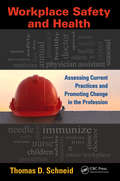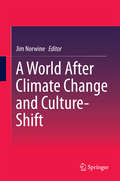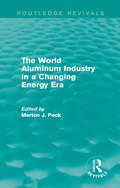- Table View
- List View
Woodland and Forest Animals: Woodland And Forest Animals (Saving Wildlife)
by Sonya NewlandWoodland & Forest Animals studies creatures under threat in woodland areas, and looks at how conservation is reversing damage caused by human activity and natural disasters.It is part of the Saving Wildlife series, which investigates the world's endangered species in the context of their different environments.
The Woodland Book: 101 ways to play, investigate, watch wildlife and have adventures in the woods
by Tessa WardleyFrom an author passionate about reconnecting both adults and children with nature, The Woodland Book aims to show anyone with an interest in nature and the great outdoors how to make the most of the unique environments provided by a canopy of trees. Packed with fascinating facts about woodlands including ancient rituals and the wildlife and flora that make it special. You'll learn how to identify different kinds of woodland, assess the age of a tree from a stump, recognise the birds that nest in the canopy by their song and meet other creatures such as bats, badgers and even the odd wild boar. Other activities include learning ancient woodland arts such as coppicing, searching for woodland fruits and building your own shelter and mythical 'green man'. Perfect for adults and children who enjoy climbing, investigating, den building, camping and generally having fun, this book will encourage readers to have fun with nature.
The Woodland Book: 101 ways to play, investigate, watch wildlife and have adventures in the woods
by Tessa WardleyFrom an author passionate about reconnecting both adults and children with nature, The Woodland Book aims to show anyone with an interest in nature and the great outdoors how to make the most of the unique environments provided by a canopy of trees. Packed with fascinating facts about woodlands including ancient rituals and the wildlife and flora that make it special. You'll learn how to identify different kinds of woodland, assess the age of a tree from a stump, recognise the birds that nest in the canopy by their song and meet other creatures such as bats, badgers and even the odd wild boar. Other activities include learning ancient woodland arts such as coppicing, searching for woodland fruits and building your own shelter and mythical 'green man'. Perfect for adults and children who enjoy climbing, investigating, den building, camping and generally having fun, this book will encourage readers to have fun with nature.
Woodland Conservation and Management
by G. F. PeterkenProfessor John Harper, in his recent Population Biology of Plants (1977), made a comment and asked a question which effectively states the theme of this book. Noting that 'one of the consequences of the development of the theory of vegetational climax has been to guide the observer's mind forwards', i. e. that 'vegetation is interpreted asa stage on the way to something', he commented that 'it might be more healthy and scientifically more sound to look more often backwards and search for the explanation of the present in the past, to explain systems in relation to their history rather than their goal'. He went on to contrast the 'disaster theory' of plant succession, which holds that communities are a response to the effects of past disasters, with the 'climax theory', that they are stages in the approach to a climax state, and then asked 'do we account most completely for the characteristics of a population by a knowledge of its history or of its destiny?' Had this question been put to R. S. Adamson, E. J. Salisbury, A. G. Tansley or A. S. Watt, who are amongst the giants of the first forty years of woodland ecology in Britain, their answer would surely have been that understanding lies in a knowledge of destiny. Whilst not unaware of the historical facts of British woodlands, they were preoccupied with ideas of natural succession and climax, and tended to interpret their observations in these terms.
Woodland Flowers: Colourful past, uncertain future (British Wildlife Collection)
by Keith KirbyObserving the plants of the forest floor – the flowers, ferns, sedges and grasses – can be a vital way of understanding our relationship with British woodland. They tell us stories about its history and past management, and can be a visible sign of progress when we get conservation right. For centuries, woodland plants have also been part of our lives in practical ways as food and medicines, and they have influenced our culture through poetry, perfume and pub signs.In this insightful and original account, Keith Kirby explores how woodland plants in Great Britain have come to be where they are, coped with living in the shade of their bigger relatives, and responded to threats in the form of storms, fires, floods, the attentions of grazing herbivores and the effects of the changing seasons. Along the way, the reader is introduced to the work of important botanists who have walked the woods in the past, collecting information on where plants occur and why. In-depth profiles of some of our most important and popular ground flora species provide extra detail and insight. Beautifully illustrated, Woodland Flowers is a must for anyone who appreciates and wants to learn more about British woodland and its plants.
Woodland Flowers: Colourful past, uncertain future (British Wildlife Collection)
by Keith KirbyObserving the plants of the forest floor – the flowers, ferns, sedges and grasses – can be a vital way of understanding our relationship with British woodland. They tell us stories about its history and past management, and can be a visible sign of progress when we get conservation right. For centuries, woodland plants have also been part of our lives in practical ways as food and medicines, and they have influenced our culture through poetry, perfume and pub signs.In this insightful and original account, Keith Kirby explores how woodland plants in Great Britain have come to be where they are, coped with living in the shade of their bigger relatives, and responded to threats in the form of storms, fires, floods, the attentions of grazing herbivores and the effects of the changing seasons. Along the way, the reader is introduced to the work of important botanists who have walked the woods in the past, collecting information on where plants occur and why. In-depth profiles of some of our most important and popular ground flora species provide extra detail and insight. Beautifully illustrated, Woodland Flowers is a must for anyone who appreciates and wants to learn more about British woodland and its plants.
Woodlands: Its History, Vegetation And Uses In England (Collins New Naturalist Library #100)
by Oliver RackhamThe 100th volume of the prestigious New Naturalist series, written by one of Britain's best-known naturalists, explores the significance and history of woodlands on the British landscape
Woodlands: Its History, Vegetation And Uses In England (Collins New Naturalist Library #100)
by Oliver Rackham‘Trees are wildlife just as deer or primroses are wildlife. Each species has its own agenda and its own interactions with human activities …’
Woodlands (PDF)
by Oliver Rackham‘Trees are wildlife just as deer or primroses are wildlife. Each species has its own agenda and its own interactions with human activities …’ Written by one of Britain’s best-known naturalists, Woodlands offers a fascinating new insight into the trees of the British landscape that have filled us with awe and inspiration throughout the centuries. Looking at such diverse evidence as the woods used in buildings and ships, and how woodland has been portrayed in pictures and photographs, Rackham traces British woodland through the ages, from the evolution of wildwood, through man’s effect on the landscape, modern forestry and its legacy, and recent conservation efforts and their effects. In his lively and thoroughly engaging style, Rackham explores woodlands and their history, through names, surveys, mapping and legal documents, archaeology, photographs and works of art, thus offering an utterly compelling insight into British woodlands and how they have come to shape a national obsession.
Woodlot Management: Storey's Country Wisdom Bulletin A-70 (Storey Country Wisdom Bulletin)
by Jay HeinrichSince 1973, Storey's Country Wisdom Bulletins have offered practical, hands-on instructions designed to help readers master dozens of country living skills quickly and easily. There are now more than 170 titles in this series, and their remarkable popularity reflects the common desire of country and city dwellers alike to cultivate personal independence in everyday life.
Woodsman: Living In A Wood In The 21st Century
by Ben LawBen Law’s incredible sense of the land and his respect for age old traditions offers a wonderful insight into the life of Prickly Nut Wood.
Woody Plants of Utah: A Field Guide with Identification Keys to Native and Naturalized Trees, Shrubs, Cacti, and Vines
by Renee Van Buren Janet G. Cooper Leila M. Shultz Kimball T. HarperA comprehensive guide that includes a vast range of species and plant communities and employs thorough, original keys. Based primarily on vegetative characteristics, the keys don't require that flowers or other reproductive features be present, like many plant guides. And this guide's attention to woody plants as a whole allows one to identify a much greater variety of plants. That especially suits an arid region such as Utah with less diverse native trees. Woody plants are those that have stems that persist above ground even through seasons that don't favor growth, due to low precipitation or temperatures. Woody Plants of Utah employs dichotomous identification keys that are comparable to a game of twenty questions. They work through a process of elimination by choosing sequential alternatives. Detailed, illustrated plant descriptions complement the keys and provide additional botanical and environmental information in relation to a useful introductory categorization of Utah plant communities. Supplementary tools include photos, distribution maps, and an illustrated glossary.
The Woolly Monkey: Behavior, Ecology, Systematics, and Captive Research (Developments in Primatology: Progress and Prospects #Vol. 39)
by Thomas R. Defler Pablo R. StevensonWoolly monkeys are large, attractive and widespread primates found throughout many parts of the Amazon basin. It is only in the last twenty-five years or so that long-term studies of woollies in their forest habitat have been successful; they have not generally been successfully kept in captivity. But now, especially because of their size, these creatures are pressed on all sides by bush meat hunters and forest fragmentation. Their future is becoming critically precarious and the editors feel that it is time to showcase these animals with a full book.The editors draw together a number of recent woolly monkey studies from three Amazonian countries, including five taxa of woolly monkeys, four of which have recently been reclassified without using new biological criteria as species rather than subspecies (Groves, 2001, 2005; Rylands & Mittermeier, 2009). This volume provides a diversity of studies by well-known researchers and advanced students on a wide range of subjects using newly generated data, including a criticism of the recent taxonomic changes. The varied information contained within The Woolly Monkey: Behavior, Ecology, Systematics and Captive Research will help readers understand these handsome animals and will, we hope, energize them to contribute to their conservation.
Wordsworth: 'Daffodils' and Other Poems (Pocket Poets #4)
by William WordsworthWilliam Wordsworth is chiefly remembered as one of the ‘Lake Poets’. Yet he was also one of the founders of English Romanticism, a writer whose early revolutionary fervor imbued his verse and his ideals.Much of Wordsworth’s work was inspired by nature, but to a style rich in lyrical imagery he brought a deep interest in liberal humanitarianism and a profound concern for the lives, habits and speech of ordinary people, especially country people.This pocket-sized collection includes: ‘I wandered lonely as a cloud’ (‘Daffodils’), ‘Ode. Intimations of Immortality’, ‘Character of the Happy Warrior’, ‘The Solitary Reaper’, ‘To a Sky-Lark’, ‘Tintern Abbey’, and extracts from ‘The Prelude’.
The Work of Literature in an Age of Post-Truth
by Christopher SchabergWhat is the role of literary studies in an age of Twitter threads and viral news?If the study of literature today is not just about turning to classic texts with age-old questions, neither is it a rejection of close reading or critical inquiry. Through the lived experience of a humanities professor in a rapidly changing world, this book explores how the careful study of literature and culture may be precisely what we need to navigate our dizzying epoch of post-truth politics and ecological urgency.
The Work of Literature in an Age of Post-Truth: Holy Places In Louisiana
by Christopher SchabergWhat is the role of literary studies in an age of Twitter threads and viral news?If the study of literature today is not just about turning to classic texts with age-old questions, neither is it a rejection of close reading or critical inquiry. Through the lived experience of a humanities professor in a rapidly changing world, this book explores how the careful study of literature and culture may be precisely what we need to navigate our dizzying epoch of post-truth politics and ecological urgency.
Workers and Trade Unions for Climate Solidarity: Tackling climate change in a neoliberal world (Routledge Studies in Climate, Work and Society)
by Paul HamptonThis book is a theoretically rich and empirically grounded account of UK trade union engagement with climate change over the last three decades. It offers a rigorous critique of the mainstream neoliberal and ecological modernisation approaches, extending the concepts of Marxist social and employment relations theory to the climate realm. The book applies insights from employment relations to the political economy of climate change, developing a model for understanding trade union behaviour over climate matters. The strong interdisciplinary approach draws together lessons from both physical and social science, providing an original empirical investigation into the climate politics of the UK trade union movement from high level officials down to workplace climate representatives, from issues of climate jobs to workers’ climate action. This book will be of great interest to students and researchers in environmental politics, climate change and environmental sociology.
Workers and Trade Unions for Climate Solidarity: Tackling climate change in a neoliberal world (Routledge Studies in Climate, Work and Society)
by Paul HamptonThis book is a theoretically rich and empirically grounded account of UK trade union engagement with climate change over the last three decades. It offers a rigorous critique of the mainstream neoliberal and ecological modernisation approaches, extending the concepts of Marxist social and employment relations theory to the climate realm. The book applies insights from employment relations to the political economy of climate change, developing a model for understanding trade union behaviour over climate matters. The strong interdisciplinary approach draws together lessons from both physical and social science, providing an original empirical investigation into the climate politics of the UK trade union movement from high level officials down to workplace climate representatives, from issues of climate jobs to workers’ climate action. This book will be of great interest to students and researchers in environmental politics, climate change and environmental sociology.
Working with Time in Qualitative Research: Case Studies, Theory and Practice (Routledge Research in Anticipation and Futures)
by Keri FacerThis volume creates a conversation between researchers who are actively exploring how working with and reflecting upon time and temporality in the research process can generate new accounts and understandings of social and cultural phenomena and bring new ways of knowing and being into existence. The book makes a significant contribution to the enhancement of the social sciences and humanities by charting research methods that link reflectively articulate notions of time to knowledge production in these areas. Contributors explore how researchers are beginning to adopt tactics such as time visibility, hacking time, making time, witnessing temporal power and caring for temporal disruptions as resources for qualitative research. The book collects fields as disparate as futures studies and history, literary analysis and urban design, utopian studies, and science and technology studies, bringing together those who are working with temporality reflexively as a powerful epistemological tool for scholarship and research inquiry. It surfaces and foregrounds the methodological challenges and possibilities raised. In so doing, this collection will serve as a resource for both new and experienced researchers in the humanities and social sciences, seeking to understand the tools that are emerging, both theoretical and methodological, for working with time as part of research design. This book will be of great interest to students and scholars of research methods, time and temporality, future studies, and the environmental humanities.
Working with Time in Qualitative Research: Case Studies, Theory and Practice (Routledge Research in Anticipation and Futures)
by Keri Facer Johan Siebers Bradon SmithThis volume creates a conversation between researchers who are actively exploring how working with and reflecting upon time and temporality in the research process can generate new accounts and understandings of social and cultural phenomena and bring new ways of knowing and being into existence. The book makes a significant contribution to the enhancement of the social sciences and humanities by charting research methods that link reflectively articulate notions of time to knowledge production in these areas. Contributors explore how researchers are beginning to adopt tactics such as time visibility, hacking time, making time, witnessing temporal power and caring for temporal disruptions as resources for qualitative research. The book collects fields as disparate as futures studies and history, literary analysis and urban design, utopian studies, and science and technology studies, bringing together those who are working with temporality reflexively as a powerful epistemological tool for scholarship and research inquiry. It surfaces and foregrounds the methodological challenges and possibilities raised. In so doing, this collection will serve as a resource for both new and experienced researchers in the humanities and social sciences, seeking to understand the tools that are emerging, both theoretical and methodological, for working with time as part of research design. This book will be of great interest to students and scholars of research methods, time and temporality, future studies, and the environmental humanities.
The Workout Bucket List: Over 300 Life-Changing Races, Epic Challenges, and Incredible Hikes, Bikes, Lifts, and Runs around the World, in Your Gym, or Right in Your Living Room
by Greg PrestoDo leg day like America's toughest firefighter, join a bicycle race in the mountains of Colorado, or get pumped like a POTUS with this unique and well researched collection of exercises that will encourage and inspire you to try some of the most challenging and ridiculously fun workouts at home and around the world!For most of us, exercise can be a dreaded task, one to be postponed, procrastinated, or avoided. We all know the excuses: exercise is boring; I don't have time for the gym; there's no room in my apartment; I need to be motivated. The real problem is that we're used to old fitness routines and the same monotonous gym equipment, but The Workout Bucket List promises that exercise can, and will, be fun again. Combine history, pop culture, travel, inspiration, and health and you've got the perfect book to help break down your mental barriers to shake up your fitness regimen. Author and fitness journalist Greg Presto suggests countless exercises and activities around the world—or in your very own home—for the ultimate fitness bucket list, whether it's biking with zebras, entering the Tour de Donut, climbing the tallest mountain east of the Mississippi, training like a Baywatch lifeguard, or starting your day with a workout that you might have done in the Titanic's gym. The Workout Bucket List is here to challenge you to try the world's toughest, most interesting, and fun workouts, inspiring the fitness adventurer in all of us.
Workplace Safety and Health: Assessing Current Practices and Promoting Change in the Profession
by Thomas D. SchneidAre the tried and true safety practices still effective in the changing workplace? Is there a better way of safeguarding employees from accidents and injuries? In short, why do you perform the safety activities that you do on a daily basis and do they produce the results necessary to keep your safety program and your company competitive in the glob
A World After Climate Change and Culture-Shift
by Jim NorwineIn this book, an international team of environmental and social scientists explain two powerful current change-engines and how their effects, and our responses to them, will transform Earth and humankind into the 22nd-century (c.2100).This book begins by detailing the current state of knowledge about these two ongoing, accelerating and potentially world-transforming changes: climate change, in the form of global warming, and a profound emerging shift of normative cultural condition toward the assumptions and values often associated with so-called postmodernity, such as tolerance, diversity, self-referentiality, and dubiety replaced with certainty. Next, the contributors imagine, explain and debate the most likely consequent transformations of human and natural ecologies and economies that will take place by the end of the 21st-century.In 16 compellingly original, provocative and readable chapters, A World after Climate Change and Culture-Shift presents a one-of-a-kind vision of our current age as a “hinge” or axial century, one driven by the most radical combined change of nature and culture since the rise of agriculture at the end of the last Ice Age some 10 millennia ago. This book is highly recommended to scholars and students of the environmental and social sciences, as well as to all readers interested in how changes in nature and culture will work together to reshape our world and ourselves."I cannot think of a book more geared to advancing the art and science of geography." - Yi-Fu Tuan, J. K. Wright and Vilas Professor Emeritus of Geography, University of Wisconsin-Madison"Outstanding," "unique," and "exceptional timeliness of topic and ambition ofvision". - Richard Marston, University Distinguished Professor, Kansas State University; past president, Association of American Geographers
The World Aluminum Industry in a Changing Energy Era (Routledge Revivals)
by Merton J. PeckAs a heavy user of electricity the primary aluminium smelting industry is a leading example of the effects of variations in energy costs. This title tells the story that with the rise in energy costs, three regions—Japan, the United States, and Western Europe –have become high-cost locations for primary aluminium production relative to three other regions—Australia, Brazil, and Canada. First published in 1988, this volume presents an analysis of the public policy choices regarding the aluminium industry and electric power in both low-cost power countries and high-cost power countries. The World Aluminium Industry in a Changing Energy World is ideal for policy makers and students interested in environmental studies.
The World Aluminum Industry in a Changing Energy Era (Routledge Revivals)
by Merton J. PeckAs a heavy user of electricity the primary aluminium smelting industry is a leading example of the effects of variations in energy costs. This title tells the story that with the rise in energy costs, three regions—Japan, the United States, and Western Europe –have become high-cost locations for primary aluminium production relative to three other regions—Australia, Brazil, and Canada. First published in 1988, this volume presents an analysis of the public policy choices regarding the aluminium industry and electric power in both low-cost power countries and high-cost power countries. The World Aluminium Industry in a Changing Energy World is ideal for policy makers and students interested in environmental studies.
